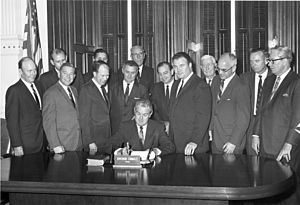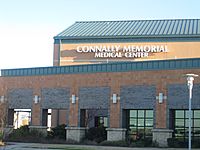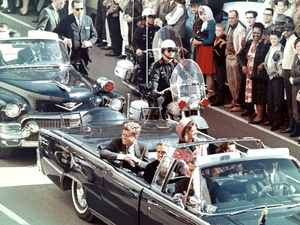John Connally facts for kids
Quick facts for kids
John Connally
|
|
|---|---|

Connally in 1961, as Secretary of the Navy
|
|
| 61st United States Secretary of the Treasury | |
| In office February 11, 1971 – June 12, 1972 |
|
| President | Richard Nixon |
| Preceded by | David M. Kennedy |
| Succeeded by | George Shultz |
| 39th Governor of Texas | |
| In office January 15, 1963 – January 21, 1969 |
|
| Lieutenant | Preston Smith |
| Preceded by | Price Daniel |
| Succeeded by | Preston Smith |
| 56th United States Secretary of the Navy | |
| In office January 25, 1961 – December 20, 1961 |
|
| President | John F. Kennedy |
| Preceded by | William B. Franke |
| Succeeded by | Fred Korth |
| Personal details | |
| Born |
John Bowden Connally Jr.
February 27, 1917 Floresville, Texas, U.S. |
| Died | June 15, 1993 (aged 76) Houston, Texas, U.S. |
| Resting place | Texas State Cemetery |
| Political party | Republican (1973–1993) |
| Other political affiliations |
Democratic (until 1973) |
| Spouse |
Nellie Brill
(m. 1940) |
| Children | 4 |
| Relatives | Wayne Connally (brother) |
| Education | University of Texas, Austin (BA, LLB) |
| Signature | |
| Military service | |
| Branch/service | United States Navy |
| Rank | Lieutenant commander |
| Battles/wars | World War II |
John Bowden Connally Jr. (February 27, 1917 – June 15, 1993) was an important American politician. He served as the 39th governor of Texas. He also became the 61st U.S. Secretary of the Treasury. He started his political life as a Democrat. Later, in 1973, he joined the Republican Party.
Connally was born in Floresville, Texas. He studied law at the University of Texas at Austin. During World War II, he served in the United States Navy. After the war, he worked for Senator Lyndon B. Johnson. When Johnson became Vice President in 1961, he helped Connally become Secretary of the Navy. Connally left this job in December 1961 to run for Governor of Texas. He served as governor from 1963 to 1969.
In 1963, Connally was riding in the car with President John F. Kennedy when Kennedy was shot. Connally was also seriously hurt. As governor, he was a conservative Democrat. In 1971, Republican President Richard Nixon chose Connally to be his Treasury Secretary. In this role, Connally helped remove the U.S. dollar from the gold standard. This big change was called the Nixon shock.
Connally left the Cabinet in 1972 to lead a group called "Democrats for Nixon". This group supported Nixon's re-election. He wanted to be Vice President in 1973 but Gerald Ford was chosen instead. Connally ran for president in the 1980 election. However, he stopped his campaign early. He did not seek public office again after 1980. Connally passed away in 1993 from a lung disease.
Contents
Early Life and Education
John Connally was born on February 27, 1917. He grew up in a large family in Floresville, Texas. This town is in Wilson County, southeast of San Antonio. He was one of seven children. His parents were Lela and John Bowden Connally, who were dairy and tenant farmers.
Connally went to Floresville High School. He was one of the few students from his school who went to college. He attended the University of Texas at Austin. There, he became the student body president. He also met his future wife, Nellie Connally, at the university. After college, he studied at the University of Texas School of Law. He then became a lawyer.
Military Service and Early Career
Connally joined the United States Navy during World War II. He first worked as an aide to James Forrestal. Later, he was part of Dwight D. Eisenhower's team. They planned the North African campaign. He then moved to the South Pacific. He directed fighter planes from the aircraft carrier USS Essex. For his bravery, he received the Bronze Star. He also earned the Legion of Merit while serving on the USS Bennington. He left the Navy in 1946 as a lieutenant commander.
After the Navy, Connally worked as a lawyer. But Lyndon B. Johnson, who was a new senator, asked him to come to Washington, D.C.. Connally became a key helper for Johnson. They had been close friends since before Connally joined the Navy. Their friendship lasted until Johnson's death in 1973.
Connally also worked for wealthy Texas oilmen, like Sid W. Richardson. This work taught him a lot about business and real estate. When Richardson died in 1959, Connally helped manage his large estate.
At the 1960 Democratic meeting in Los Angeles, Connally supported Senator Lyndon Johnson. Johnson became the running mate for John F. Kennedy. Kennedy and Johnson won the 1960 presidential election.
In 1961, President Kennedy chose Connally to be Secretary of the Navy. This was at Johnson's request. Connally resigned after eleven months to run for Governor of Texas. During his time as Secretary, the Navy had a large budget. It also had over 1.2 million workers.
Connally used the Navy to perform "gunboat diplomacy". This meant using naval power in a friendly way. For example, the USS Forrestal visited Naples, Italy. Sailors brought gifts to children in an orphanage. Gifts were also sent to hospitals and children in other countries. The Bay of Pigs Invasion happened while he was Secretary.
Connally worked hard to keep the Navy involved in the national space program. He did not want most space research to go to the Air Force. Time magazine called his year as Navy Secretary "a first-rate appointment." However, some noted his time was too short for many big achievements.
Running for Governor of Texas
In December 1961, Connally announced he would run for governor. He wanted the Democratic nomination for the 1962 Texas gubernatorial election. He ran against the current governor, Price Daniel. Daniel was not very popular because of a new state sales tax. Another opponent was Don Yarborough, a liberal lawyer from Houston.
Connally ran as a conservative Democrat. He campaigned very actively. He traveled over 22,000 miles across Texas. He gave many speeches and appeared on TV. He was known as a "total professional" in campaigning. He would make sure his arrival at events was noticed.
He won a close primary runoff election against Yarborough. His Republican opponent for governor was Jack Cox. Connally won the election with 54% of the votes.
Governor of Texas
Connally served as governor from 1963 to 1969. He won re-election easily in 1964 and 1966. His large wins gave him more power with the state legislature.
As governor, Connally greatly expanded higher education in Texas. He signed a law to create the Texas Higher Education Coordinating Board. He also appointed leaders who supported allowing women into Texas A&M University. This university had been all-male before.

Connally also supported HemisFair '68. This was a world's fair held in San Antonio. He believed it would bring a lot of money to the state. He wanted the fair's Texas Pavilion to become a permanent museum. This museum is now the Institute of Texan Cultures. He imagined it as a place to show the many different people who built Texas.
There was talk of Connally becoming Hubert Humphrey's running mate in 1968. But Edmund Muskie was chosen instead. Connally publicly supported Humphrey. However, some say he also secretly helped Richard Nixon. Connally was followed as governor by Preston Smith.
The Kennedy Assassination
On November 22, 1963, Governor Connally was in President Kennedy's car in Dealey Plaza in Dallas. President Kennedy was shot and killed. Connally, who was sitting in front of the president, was also seriously wounded.
He heard the first shot and knew it was from a rifle. He quickly feared an assassination. He looked back at the president. Then he felt a strong hit in his back. He later said, "My God, they are going to kill us all." He saw blood on his chest and thought he was fatally shot. He then heard the third shot. This shot sprayed blood and brain tissue on the car's passengers.
Connally suffered a broken rib and a punctured lung. His wrist was shattered, and a bullet was in his leg. He had four hours of surgery and recovered from his injuries. The Warren Commission investigated the assassination. They concluded that Lee Harvey Oswald acted alone. Connally did not agree with the "single bullet theory". This theory said one bullet went through Kennedy and caused all of Connally's wounds. Connally believed three separate shots hit the people in the car. However, he publicly agreed that Oswald acted alone.
Secretary of the Treasury
In 1971, Republican President Nixon appointed Connally, a Democrat at the time, as his Treasury Secretary. Before accepting, Connally asked Nixon to find a job for George H. W. Bush. Bush had lost a Senate race in Texas. Connally felt it would be unfair to Bush if he took the job, since Bush had worked hard for Nixon. Nixon then made Bush the ambassador to the United Nations. This helped Nixon get Connally to join his team.
Soon after becoming Treasury Secretary, Connally made a famous statement. European finance ministers were worried about American inflation. Connally told them the dollar "is our currency, but your problem."
Secretary Connally supported increasing the national debt. He also backed a large budget deficit. He called these steps a "fiscal stimulus" to help the economy. At that time, many Americans were unemployed. He also announced Nixon's plan to raise the price of gold. This officially devalued the dollar. It meant the U.S. was leaving the old gold standard completely. Prices kept rising in 1971. Nixon then allowed rules to control wages and prices. Connally also worked to solve trade problems with other countries. He took important trips for President Nixon.
Historian Bruce Schulman said Nixon was very impressed by Connally. Henry Kissinger, Nixon's top security advisor, noted that Connally was the only cabinet member Nixon never spoke badly about. This showed how much Nixon respected him.
Switching Political Parties
In 1972, Connally left his job as Treasury Secretary. He then led "Democrats for Nixon". This group was funded by Republicans. Its goal was to get Democrats to support Nixon in the 1972 presidential election. Connally's old mentor, Lyndon B. Johnson, supported the Democratic candidate, George McGovern. This was the first time Connally and Johnson were publicly on opposite sides in an election.
In January 1973, Lyndon B. Johnson died. Connally and Johnson had been friends since 1938. Connally gave a speech at Johnson's funeral.
In May 1973, Connally joined the Republican Party. Five months later, Vice President Spiro Agnew resigned due to a scandal. Connally was one of Nixon's choices to replace him. But Nixon chose Gerald Ford instead. Nixon thought Congress would be more likely to approve Ford.
Trial and Acquittal
In July 1974, Connally faced legal challenges. He was accused of receiving money to influence a milk price decision. At his trial in April 1975, many famous people spoke on his behalf. These included former First Ladies Jacqueline Kennedy and Lady Bird Johnson. Also, Texas state senator Barbara Jordan, Dean Rusk, Robert McNamara, and Billy Graham spoke for him.
The case largely depended on whether Connally or another lawyer, Jake Jacobsen, was telling the truth. Because of the strong character witnesses, Connally was found not guilty.
1980 Presidential Campaign
In January 1979, Connally announced he would run for the Republican nomination for President in 1980. He was known as a great speaker and a strong leader. He was even on the cover of Time magazine. But his past image as a "wheeler-dealer" was still a challenge.
Connally raised more money than any other candidate. However, he could not catch up to the popular Ronald Reagan. Connally spent his money across the country. Meanwhile, George H. W. Bush, another candidate from Houston, focused his efforts on early voting states. Bush won the Iowa caucus.
After losing in Iowa, Connally focused on South Carolina. But he lost there to Reagan. He then withdrew from the race. Even though he spent $11 million, he only secured one delegate. This delegate, Ada Mills, became known as the "$11 million delegate."
After leaving the race, Connally supported Reagan. He appeared with Reagan at events. When asked if Reagan was the best man for president, Connally joked, "I think he's the second best man I can think of."
Later Years and Passing
In 1986, Connally had to file for bankruptcy. This was due to several business losses in Houston. In December 1990, Connally met with President Saddam Hussein of Iraq. Hussein was holding foreigners as hostages. After their meeting, Hussein agreed to release the hostages.

In one of his last political actions, Connally supported Republican congressman Jack Fields. This was for a special election in May 1993.
On May 17, 1993, Connally had trouble breathing. He was taken to a hospital in Houston. He passed away on June 15, at age 76. The cause was pulmonary fibrosis, a lung disease.
After Connally died, some researchers asked to examine bullet fragments from his body. They believed this could help understand the Kennedy assassination better. However, Connally's family did not give permission.
His funeral was held on June 17, 1993, in Austin. Former President Nixon attended the service. Connally's wife, Nellie, passed away in 2006. They are buried together at the Texas State Cemetery in Austin.
Legacy and Recognition
Many places and buildings in Texas are named after John Connally. These include schools like John B. Connally Middle School and John B. Connally High School. Texas A&M University and Texas State Technical College each have a building named for him.
A part of Interstate 410 in San Antonio is called the Connally Loop. The John B. Connally Unit is a prison in Karnes County. The Connally Memorial Medical Center in Floresville is named for his family. In downtown Houston, there is a life-sized statue of Connally.
In January 1964, Connally gave the suit he wore on November 22, 1963, to the Texas State Library and Archives Commission. The suit was displayed to the public for a short time. In 2000, it was loaned for examination. From October 2013 to February 2014, the suit was part of an exhibit. This exhibit marked 50 years since the Kennedy assassination.
See also
 In Spanish: John Connally para niños
In Spanish: John Connally para niños
- List of U.S. political appointments that crossed party lines
- List of governors of Texas







